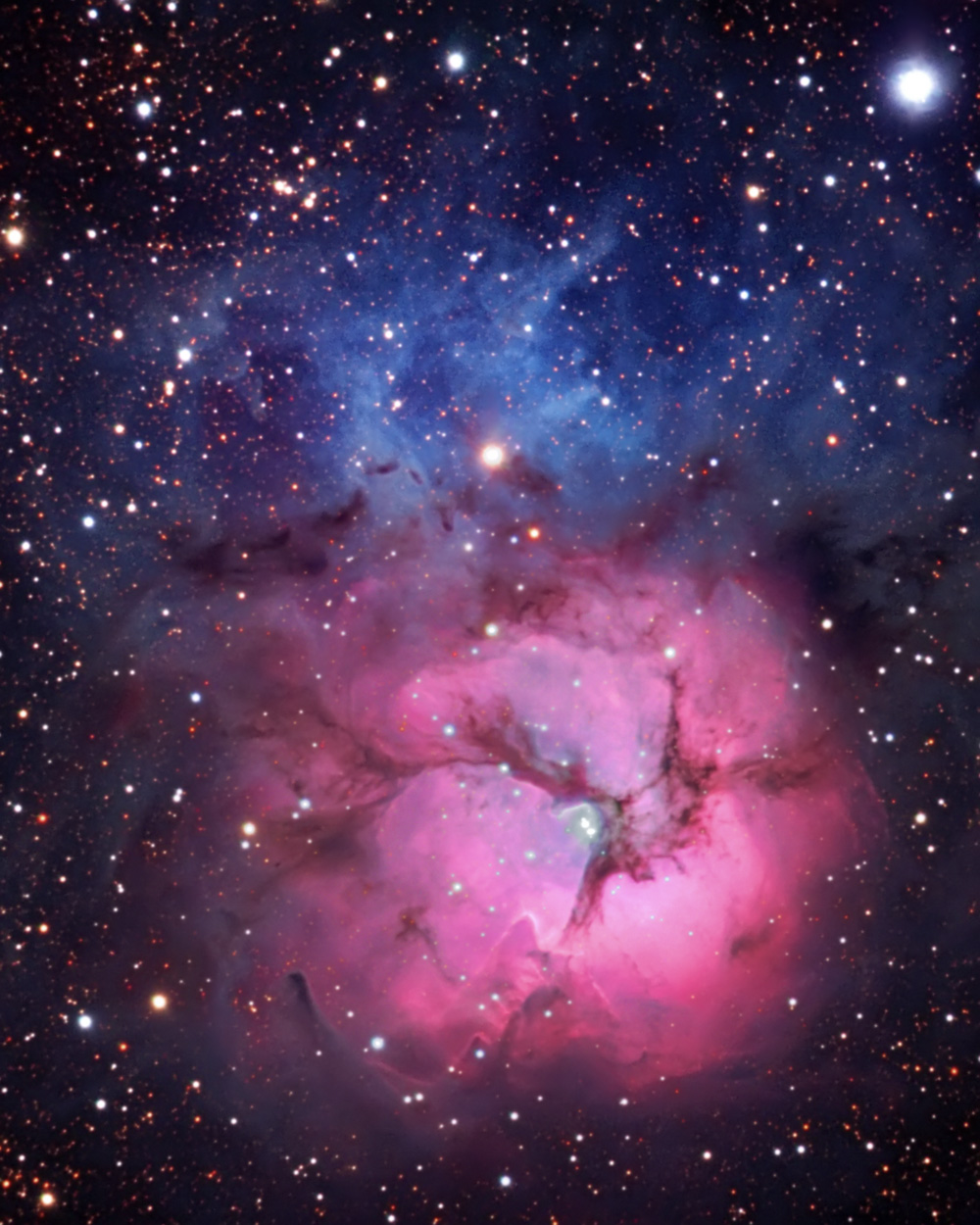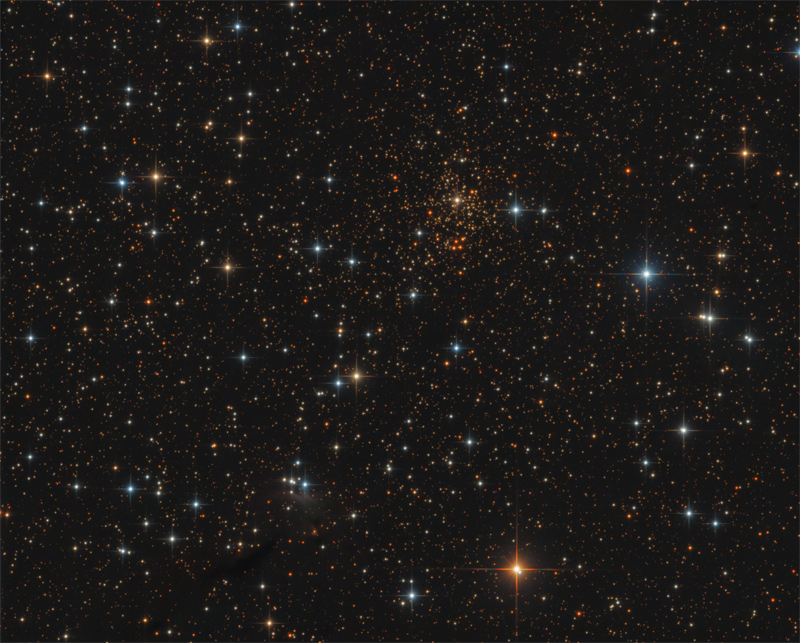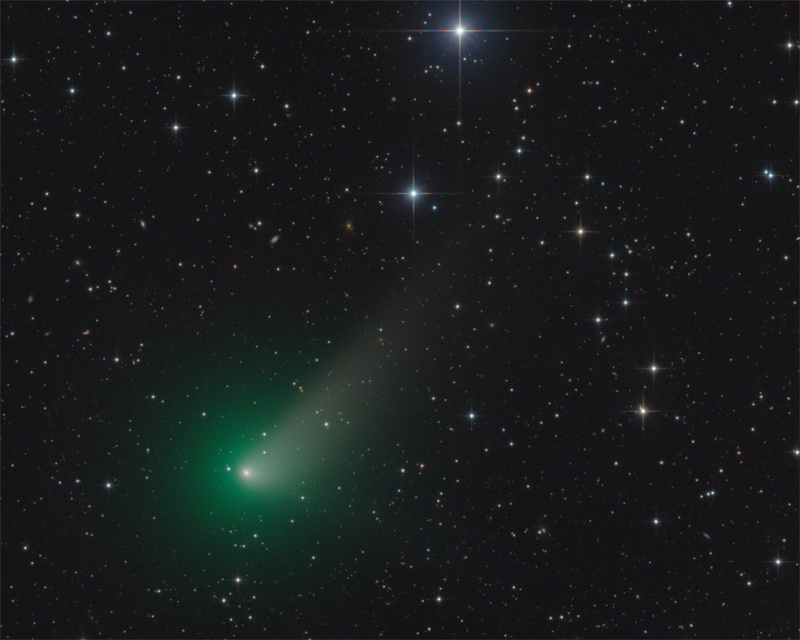Page 2 of 2
Re: Found images: 2017 July
Posted: Sat Jul 15, 2017 10:27 am
by starsurfer
ESO: Billions of New Neighbours? (RCW 38)
Posted: Mon Jul 17, 2017 1:40 pm
by bystander
Billions of New Neighbours?
ESO Picture of the Week | 2017 Jul 17
[img3="ESO/Koraljka Muzic (University of Lisbon), Aleks Scholz (University of St Andrews), Rainer Schoedel (Institituto de Astrofísica de Andalucía), Vincent Geers (UKATC), Ray Jayawardhana (York University), Joana Ascenso (Univeristy of Porto & University of Lisbon) & Lucas Cieza (University Diego Portales)"]https://cdn.eso.org/images/large/potw1729a.jpg[/img3][hr][/hr] The objects that astronomers call
brown dwarfs sit somewhere between the definition of a planet and a star. They are balls of gas with more mass than a planet, but not enough mass to sustain stable hydrogen
fusion like a star. Because they hardly emit any visible light, they were only first discovered in 1995 and up until today the majority of known brown dwarfs are within 1500 light-years of us.
Now, astronomers using the
NACO adaptive optics infrared camera on ESO’s
Very Large Telescope have observed the star cluster
RCW 38 in the constellation
Vela (
the Sail), about 5500 light-years away. This
Picture of the Week shows the the central part of RCW 38; the inserts on the sides show a subset of the brown dwarf candidates detected within the cluster.
The scientists found half as many brown dwarfs as stars in the cluster. From these results and from studying other star clusters, the astronomers estimate that the Milky Way contains at least between 25 to 100 billion brown dwarfs. RCW 38 probably contains even more less massive, fainter brown dwarfs, which are beyond the detection limits of this image — so this new estimate could actually be a significant underestimation. Further surveys will reveal the true number of brown dwarfs lurking in the Milky Way.
http://asterisk.apod.com/viewtopic.php?t=37359#p272709
HEIC: Dim and Diffuse (NGC 4242)
Posted: Mon Jul 17, 2017 1:46 pm
by bystander
Dim and Diffuse
ESA Hubble Picture of the Week | 2017 Jul 17
Tucked away in the small northern constellation of
Canes Venatici (
The Hunting Dogs) is the galaxy
NGC 4242, shown here as seen by the NASA/ESA Hubble Space Telescope. The galaxy lies some 30 million light-years from us. At this distance from Earth, actually not all that far on a cosmic scale, NGC 4242 is visible to anyone armed with even a basic telescope (as British astronomer
William Herschel found when he discovered the galaxy in 1788).
This image shows the galaxy’s bright centre and the surrounding dimmer and more diffuse “fuzz”. Despite appearing to be relatively bright in this image, studies have found that NGC 4242 is actually relatively dim (it has a moderate-to-low surface brightness and low luminosity) and also supports a low rate of star formation. The galaxy also seems to have a weak bar of stars cutting through its asymmetric centre, and a very faint and poorly-defined spiral structure throughout its disc. But if NGC 4242 is not all that remarkable, as with much of the Universe, it is still a beautiful and ethereal sight.
Re: Found images: 2017 July
Posted: Mon Jul 17, 2017 2:14 pm
by starsurfer
Re: Found images: 2017 July
Posted: Mon Jul 17, 2017 2:17 pm
by starsurfer
P Cygni nebula
http://www.cxielo.ch/gallery/f/p-cygni
Copyright: Martin Rusterholz
Re: ESO: Billions of New Neighbours? (RCW 38)
Posted: Mon Jul 17, 2017 4:44 pm
by Ann
bystander wrote:Billions of New Neighbours?
ESO Picture of the Week | 2017 Jul 17
[img3="ESO/Koraljka Muzic (University of Lisbon), Aleks Scholz (University of St Andrews), Rainer Schoedel (Institituto de Astrofísica de Andalucía), Vincent Geers (UKATC), Ray Jayawardhana (York University), Joana Ascenso (Univeristy of Porto & University of Lisbon) & Lucas Cieza (University Diego Portales)"]https://cdn.eso.org/images/large/potw1729a.jpg[/img3][hr][/hr] The objects that astronomers call
brown dwarfs sit somewhere between the definition of a planet and a star. They are balls of gas with more mass than a planet, but not enough mass to sustain stable hydrogen
fusion like a star. Because they hardly emit any visible light, they were only first discovered in 1995 and up until today the majority of known brown dwarfs are within 1500 light-years of us.
Now, astronomers using the
NACO adaptive optics infrared camera on ESO’s
Very Large Telescope have observed the star cluster
RCW 38 in the constellation
Vela (
the Sail), about 5500 light-years away. This
Picture of the Week shows the the central part of RCW 38; the inserts on the sides show a subset of the brown dwarf candidates detected within the cluster.
The scientists found half as many brown dwarfs as stars in the cluster. From these results and from studying other star clusters, the astronomers estimate that the Milky Way contains at least between 25 to 100 billion brown dwarfs. RCW 38 probably contains even more less massive, fainter brown dwarfs, which are beyond the detection limits of this image — so this new estimate could actually be a significant underestimation. Further surveys will reveal the true number of brown dwarfs lurking in the Milky Way.
http://asterisk.apod.com/viewtopic.php?t=37359#p272709
I have nothing much to say about the brown dwarfs, but here is some info on the rest of RCW 38:
Scott J. Wolk, Tyler L. Bourke, Miquela Vigil wrote:
RCW~38 is a uniquely young (<1 Myr), embedded (AV∼10) stellar cluster surrounding a pair of early O stars (∼O5.5) and is one of the few regions within 2 kpc other than Orion to contain over 1000 members. X-ray and deep near-infrared observations reveal a dense cluster with over 200 X-ray sources and 400 infrared sources embedded in a diffuse hot plasma within a 1 pc diameter. The central O star has evacuated its immediate surroundings of dust, creating a wind bubble ∼0.1 pc in radius...
RCW~38 appears similar in structure to RCW~49 and M~20 but is at an earlier evolutionary phase. RCW~38 appears to be a blister compact H{\small II} region lying just inside the edge of a giant molecular cloud.
RCW 49. Credit: E. Churchwell (Univ. Wisconsin), JPL, Caltech, NASA
The Trifid Nebula. Photo: Jason Ware.
So RCW 38 is similar to RCW 49 and the Trifid Nebula. That's interesting, I think!
And perhaps the Trifid Nebula, too, is full of brown dwarfs.
Ann
Re: Found images: 2017 July
Posted: Tue Jul 18, 2017 8:28 am
by starsurfer
Flaming Star Nebula (IC 405), Tadpole Nebula (IC 410) and IC 417
http://www.straightontillmorning.me/Ast ... 9wpcVH7/X2
Copyright: Hytham Abu-Safieh
Re: Found images: 2017 July
Posted: Wed Jul 19, 2017 11:47 am
by starsurfer
Re: Found images: 2017 July
Posted: Thu Jul 20, 2017 12:17 pm
by starsurfer
Re: Found images: 2017 July
Posted: Fri Jul 21, 2017 4:22 pm
by starsurfer
Re: Found images: 2017 July
Posted: Sat Jul 22, 2017 2:42 pm
by starsurfer
King 7 and GM 1-34
http://www.astrophoton.com/OCL_King07.htm
Copyright: Bernhard Hubl
Re: Found images: 2017 July
Posted: Sun Jul 23, 2017 6:16 pm
by starsurfer
Re: Found images: 2017 July
Posted: Mon Jul 24, 2017 11:27 am
by starsurfer
Re: Found images: 2017 July
Posted: Mon Jul 24, 2017 11:29 am
by starsurfer
Red Rectangle Nebula
http://www.chart32.de/index.php/component/k2/item/105
Copyright: CHART32
Processing: Bernd Flach-Wilken and Johannes Schedler
ESO: Seeing Double (NGC 7098)
Posted: Mon Jul 24, 2017 4:17 pm
by bystander
Seeing Double
ESO Picture of the Week | 2017 Jul 24
Approximately 95 million light-years away, in the southern constellation of
Octans (
The Octant), lies
NGC 7098 — an intriguing spiral galaxy with numerous sets of double features. The first of NGC 7098’s double features is a duo of distinct ring-like structures that loop around the galaxy’s hazy heart. These are NGC 7098’s
spiral arms, which have wound themselves around the galaxy’s luminous core. This central region hosts a second double feature: a
double bar.
NGC 7098 has also developed features known as ansae, visible as small, bright streaks at each end of the central region. Ansae are visible areas of overdensity — they commonly take looping, linear, or circular shapes, and can be found at the extremities of planetary ring systems, in nebulous clouds, and, as is the case with NGC 7098, in parts of galaxies that are packed to the brim with stars.
This image is formed from data gathered by the FOcal Reducer and low dispersion Spectrograph (
FORS) instrument, installed on ESO’s
Very Large Telescope at Paranal Observatory. An array of distant galaxies are also visible throughout the frame, the most prominent being the small, edge-on, spiral galaxy visible to the left of NGC 7098, known as ESO 048-G007.
HEIC: A Cosmic Atlas (NGC 4248)
Posted: Mon Jul 24, 2017 4:30 pm
by bystander
A Cosmic Atlas
ESA Hubble Picture of the Week | 2017 Jul 24
This beautiful clump of glowing gas, dark dust, and glittering stars is the
spiral galaxy NGC 4248, located about 24 million light-years away in the constellation of
Canes Venatici (
The Hunting Dogs).
This image was produced by the NASA/ESA
Hubble Space Telescope as it embarked upon compiling the first Hubble ultraviolet “
atlas”, for which the telescope targeted 50 nearby star-forming galaxies. A
sample spanning all kinds of different morphologies, masses, and structures. Studying this sample can help us to piece together the star-formation history of the Universe.
By exploring how massive stars form and evolve within such galaxies, astronomers can learn more about how, when, and where
star formation occurs, how
star clusters change over time, and how the process of forming new stars is related to the properties of both the host galaxy and the surrounding
interstellar medium (the “stuff” that fills the space between individual stars).
This image is formed of observations from Hubble’s
Wide Field Camera 3.
Re: HEIC: A Cosmic Atlas (NGC 4248)
Posted: Mon Jul 24, 2017 5:35 pm
by Ann
bystander wrote:A Cosmic Atlas
ESA Hubble Picture of the Week | 2017 Jul 24
This beautiful clump of glowing gas, dark dust, and glittering stars is the
spiral galaxy NGC 4248, located about 24 million light-years away in the constellation of
Canes Venatici (
The Hunting Dogs).
This image was produced by the NASA/ESA
Hubble Space Telescope as it embarked upon compiling the first Hubble ultraviolet “
atlas”, for which the telescope targeted 50 nearby star-forming galaxies. A
sample spanning all kinds of different morphologies, masses, and structures. Studying this sample can help us to piece together the star-formation history of the Universe.
By exploring how massive stars form and evolve within such galaxies, astronomers can learn more about how, when, and where
star formation occurs, how
star clusters change over time, and how the process of forming new stars is related to the properties of both the host galaxy and the surrounding
interstellar medium (the “stuff” that fills the space between individual stars).
This image is formed of observations from Hubble’s
Wide Field Camera 3.
M106 with companion NGC 4248 (bottom right).
Photo: R Jay GaBany.
It's so small!!!

NGC 4248 is a satellite of large spiral galaxy M106. Look how tiny NGC 4248 is!
NGC 4248, gri image.
Photo: SDSS.
The Large Magellanic Cloud for comparison.
Photo: Wei-Hao Wang.
NGC 4248
isn't profusely blue. Its B-V index is 0.590, which isn't that much bluer than the B-V index of big bully galaxy M106 (0.690). NGC 4248 is no Large Magellanic Cloud! And that's not so much because the B-V of LMC is so much bluer than the B-V of NGC 4248, but because the LMC is shining and sparkling with pink emission nebulas and star formation. There is nowhere near as much of that in NGC 4248 as in the LMC. Look at the SDSS
gri image of NGC 4248. In
gri images, hydrogen alpha emission (that is, red hydrogen emission) is shown as green. There is one obvious spot of green in the dust lane of NGC 4248, so there is one very definite emission nebula there. That's not a lot, although it is so much more than the satellites of big bad Andromeda galaxy can show for themselves!
Ann
Re: Found images: 2017 July
Posted: Sat Jul 29, 2017 11:27 am
by starsurfer
Re: Found images: 2017 July
Posted: Sat Jul 29, 2017 11:30 am
by starsurfer
Re: Found images: 2017 July
Posted: Sat Jul 29, 2017 11:34 am
by starsurfer
DG 180
http://www.deeplook.astronomie.at/dg%20180.htm
Copyright: Markus Blauensteiner and Manfred Wasshuber
Re: Found images: 2017 July
Posted: Sat Jul 29, 2017 11:35 am
by starsurfer
Hen 2-437
http://www.spacetelescope.org/images/potw1606a/
Copyright: ESA/Hubble & NASA
Acknowledgement: Judy Schmidt
Re: Found images: 2017 July
Posted: Sun Jul 30, 2017 11:19 am
by starsurfer
Re: Found images: 2017 July
Posted: Mon Jul 31, 2017 8:26 am
by starsurfer
NGC 891
http://www.astro-koop.de/?attachment_id=1659
Copyright: Stefan Heutz, Wolfgang Ries and Michael Breite
ESO: Spot the Cluster (PLCKESZ G286.6-31.3)
Posted: Mon Jul 31, 2017 2:50 pm
by bystander
Spot the Cluster
ESO Picture of the Week | 2017 Jul 31
[c][attachment=0]potw1731a[1].jpg[/attachment][/c][hr][/hr]
This image from the
Wide-Field Imager on the
MPG/ESO 2.2-metre telescope shows the starry skies around a
galaxy cluster named
PLCKESZ G286.6-31.3. The cluster itself is difficult to spot initially, but shows up as a subtle clustering of yellowish galaxies near the centre of the frame.
PLCKESZ G286.6-31.3 houses up to 1000 galaxies, in addition to large quantities of hot gas and
dark matter. As such, the cluster has a total mass of 530 trillion (530 000 000 000 000) times the mass of the Sun.
When viewed from Earth, PLCKESZ G286.6-31.3 is seen through the outer fringes of the
Large Magellanic Cloud (LMC) — one of the Milky Way’s
satellite galaxies. The LMC hosts over 700
star clusters, in addition to hundreds of thousands of
giant and
supergiant stars. The majority of the cosmic objects captured in this image are stars and star clusters located inside the LMC .
The MPG/ESO 2.2-metre telescope has been in operation at ESO’s
La Silla Observatory since 1984. The telescope has been utilised for a variety of cutting-edge scientific studies, including ground-breaking research into
gamma-ray bursts, the most powerful explosions in the Universe. The 67-million-pixel Wide Field Imager (WFI) — mounted on the telescope’s
Cassegrain focus — has been obtaining detailed views of faint, distant objects since 1999.
The data to create this image was selected from the ESO archive as part of the
Hidden Treasures competition.
HEIC: The Hockey Stick Galaxy (NGC 4656)
Posted: Mon Jul 31, 2017 3:03 pm
by bystander
The Hockey Stick Galaxy
ESA Hubble Picture of the Week | 2017 Jul 31
The star of this
Hubble Picture of the Week is a galaxy known as
NGC 4656, located in the constellation of
Canes Venatici (
The Hunting Dogs). However, it also has a somewhat more interesting and intriguing name: the Hockey Stick Galaxy! The reason for this is a little unclear from this partial view, which shows the bright central region, but the galaxy is actually shaped like an elongated, warped stick, stretching out through space until it curls around at one end to form a striking imitation of a celestial hockey stick.
This unusual shape is thought to be due to an
interaction between NGC 4656 and a couple of near neighbours,
NGC 4631 (otherwise known as The Whale Galaxy) and
NGC 4627 (a small elliptical).
Galactic interactions can completely reshape a celestial object, shifting and warping its constituent gas, stars, and dust into bizarre and beautiful configurations. The NASA/ESA Hubble Space Telescope has spied a large number of interacting galaxies over the years, from the cosmic rose of
Arp 273 to the egg-penguin duo of
Arp 142 and the pinwheel swirls of
Arp 240. More Hubble images of interacting galaxies can be seen
here.









